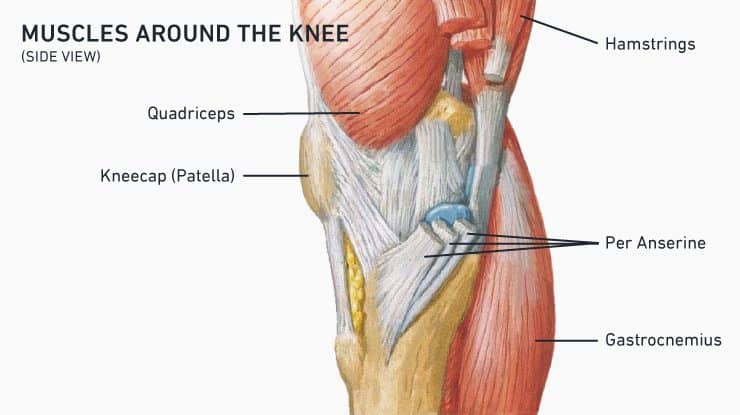Knee pain – that relentless companion that haunts your every step, making every move a challenge. Whether it’s post-surgery recovery, osteoarthritis, meniscus tears, or other common knee issues, knee pain can feel like a vicious cycle. Exercise hurts, but not exercising only makes things worse. This is because your muscles need to be strong to support your joints, but the pain keeps you from doing the very exercises that can help. Enter EMS (Electro Muscle Stimulation) training—a game changer in knee rehabilitation and pain management.
THE KNEE PAIN CONUNDRUM
When dealing with knee pain or injury, it often feels like a no-win situation. Exercise is crucial for building muscle strength around the knee joint, which in turn reduces pain and provides better support. However, the pain itself makes exercising difficult, creating a frustrating cycle of inactivity and discomfort. EMS training offers a solution by activating the muscles that are failing or wasting away due to inactivity —such as the quadriceps, hamstrings, and glutes—using simplified movements where EMS provides the resistance and work. This means you can strengthen your muscles without the need for exercises that may be painful, such as squats or lunges, until you’re ready for them.
HOW EMS CAN HELP CONQUER KNEE PAIN
EMS training utilises carefully calibrated electrical impulses to stimulate muscle contractions, bypassing the limitations of voluntary muscle activation. This means that even when your muscles are weak or your brain to muscle connection isn’t at its best, EMS can still activate the muscles effectively, providing the benefits of exercise without the associated pain. Here’s how you can use EMS to alleviate knee pain and improve strength:
STEP-BY-STEP GUIDE TO TARGETING KNEE PAIN WITH EMS
1. Start Simple: Your EMS trainer will begin with simple, low-impact exercises like sitting on the floor and raising your legs. These exercises might seem easy, but with EMS, they become a significant challenge. The electrical impulses ensure your muscles are working hard without putting stress on your knees.
2. Focus on Key Muscle Groups: Through simple exercises and the right intensity the focus of sessions should be on strengthening the quadriceps, hamstrings, and glutes—muscles that play a critical role in supporting your knee joint. EMS targets these muscles precisely, helping to build strength without causing pain.

3. Adjust Intensity: The EMS trainer will adjust the intensity of the electrical impulses to match your comfort level and progress. They’ll start with a lower setting and gradually increase it as your strength improves, ensuring a safe and effective workout tailored to your needs.
4. Consistency is Key: EMS training sessions should be done consistently 1-2 times per week. You will notice after a few weeks that you are experiencing strength gains and movements are becoming easier. But this is just the start! Consistency is essential for building muscle strength and reducing knee pain over time.
COMMON KNEE ISSUES AND HOW EMS CAN HELP
Post-Surgery Recovery
After knee reconstruction or replacement, regaining strength is crucial but challenging. EMS can activate the muscles around the knee joint without putting undue stress on the surgical site, aiding in faster recovery and better outcomes.
Osteoarthritic Pain
Osteoarthritis causes pain and stiffness in the joints, making movement difficult. EMS can help by strengthening the muscles around the knee, reducing the load on the joint, and alleviating pain.
Meniscus Tears
Meniscus tears can limit your ability to perform weight-bearing exercises. EMS allows you to strengthen the muscles without the need for high-impact movements, aiding in recovery and preventing further injury.
Other Common Knee Complaints
Whether it’s tendonitis, bursitis, or general knee instability, EMS can provide targeted muscle activation and support, helping to alleviate pain and improve function.
AVOIDING COMMON MISTAKES WITH EMS TRAINING
Pain During Exercise
If you experience pain during EMS training something is wrong! It’s important to adjust the intensity or positioning of the electrodes to get a challenging, comfortable workout. Communicate with your EMS trainer to ensure the settings are optimised for your comfort and effectiveness.
Getting Ahead of Yourself
It can be easy to want to jump ahead into more difficult and more weight bearing exercises. EMS training gives you this ability to make strength gains with very very very simple exercises….and after a few weeks you may feel ready to set your sights high with higher impact movements. BUT…remember to take it slow and progress 1 step at a time.
Focus on the small wins
Knee pain is one of those niggly things that can interfere with everyday life. So whilst you might feel frustrated that you can’t run marathons or jump up and down like a rockstar, remember that you need to focus on the small wins. Make a mental note before you start EMS training of how it feels to walk up and down stairs, get up and down from the floor, squat down to unstack the dishwasher, or get in and out of the car. Cause week by week these everyday tasks will get easier, and then you can start to think about those marathons again!
FINAL THOUGHTS
EMS training offers a revolutionary approach to managing knee pain and injuries. By activating muscles with electrical impulses, EMS allows you to build strength and support around the knee joint without the associated pain of traditional exercises. Whether you’re recovering from surgery, dealing with osteoarthritis, or facing other knee issues, EMS can help you break the cycle of pain and inactivity. So, take a seat, raise those legs, and let EMS do the work—your knees will thank you!



